Multi-stock Harvest Management in the Atlantic Flyway
Since 2000, the general duck hunting season frameworks (e.g., season length and total duck bag limit) have been set in the Atlantic Flyway based on the status of mallards breeding in the Atlantic Flyway Breeding Waterfowl Survey (AFBWS, Virginia north to New Hampshire) and portions of southern Canada (Figure 1). Eastern Mallard Adaptive Harvest Management strives to provide maximum harvest opportunity into the future by weighing current mallard population levels, harvest levels, and projections of future mallard population growth. As the mallard population grows, there is more harvest opportunity. Should the mallard population decline, there is less opportunity.
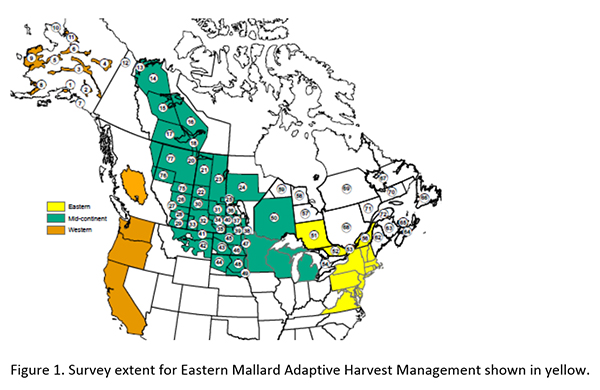
Since 1996, the mallard population in the Atlantic Flyway Breeding Waterfowl Survey has been steadily declining, while breeding mallards in southern Canada have been slowly increasing. The overall trend in breeding mallards, however, has been a slow, steady decline (Figures 2 and 3). The relative abundance of mallards in the AFBWS area is still greater than the abundance in southern Canada. As the mallard population has declined, so too has the mallard harvest (Figure 4). While mallard populations in the Flyway have been declining, most of the other duck species, except for sea ducks, are experiencing positive population growth.
The declining mallard population has led to a much more conservative approach to duck harvest for all species in the Flyway. In two of the past six years, the Atlantic Flyway has come very close to having either a closed or severely restricted duck hunting season. In 2011, the hunting season closure threshold was a breeding mallard population of 675,000 – the breeding population was estimated at 746,000. In 2017, the hunting season closure threshold was 550,000 mallards, and the breeding population was only 650,000.
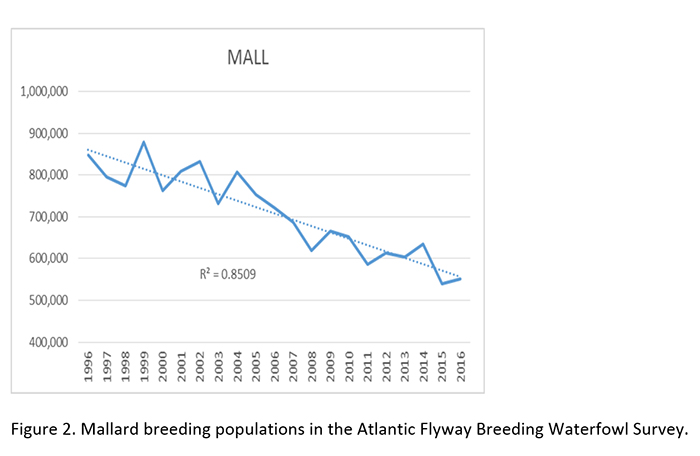
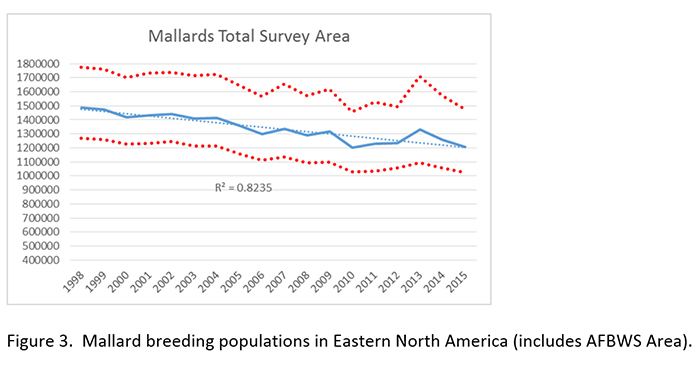
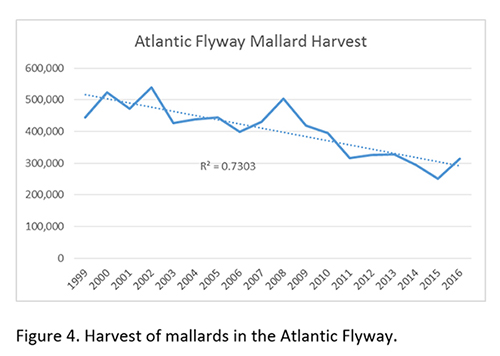
Since 2011, the Atlantic Flyway has been developing a new Adaptive Harvest Management protocol for setting the general duck season that does not rely on the status of mallards. Mallards are not doing well, even though most other species are. It is not reasonable to base the harvest opportunity of all species on just one species, particularly one that does not represent the interests of a large portion of the Atlantic Flyway duck hunters. This new protocol, Multi-stock Adaptive Harvest Management, will be implemented for the 2019-2020 hunting season, using the status of four species to set the general duck season frameworks. These four species – wood duck, ring-necked duck, American green-winged teal, and common goldeneye – are important species for hunters across the Atlantic Flyway, and represent the entirety of habitat types used by ducks within the Flyway. Setting hunting seasons based on species that represent the diversity of breeding and wintering habitats in the Flyway creates a direct link between conservation efforts to protect and enhance habitat and hunting opportunity.
Similar to the other Adaptive Harvest Management protocols, the Multi-stock Adaptive Harvest Management consists of a number of key components:
-
Population models that predict the effects of harvest and environmental factors on the abundance of each of the four species
-
A measure of reliability of each population model
-
An overall harvest objective
-
A limited set of hunting season packages, or regulatory alternatives.
The breeding range of the eastern populations of the four species is defined as follows:
Wood Duck: The breeding population occurring in the 17 states of the Atlantic Flyway (Figure 5).
Ring-necked duck, American green-winged teal, and common goldeneye: The breeding population in Canada from western Ontario to the Maritimes (Figure 6).
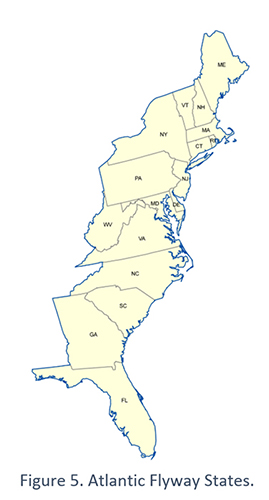
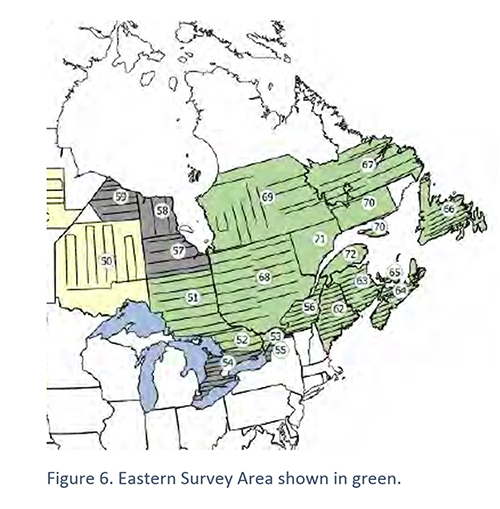
Breeding population estimates for each of the four species are determined through annual surveys. These estimates are used, along with estimates of harvest rate from the previous season, in population models for each species. The models allow biologists to estimate carrying capacity and the status of each population in relation to carrying capacity – this relationship is critical. The management objective is to provide enough habitat on the ground so that populations are abundant and resilient enough to allow for a relatively high annual harvest rate. Understanding the species population level in relation to the amount of available habitat allows biologists to make better decisions each year as to what hunting regulations will most likely achieve the goals.
In the process of developing Multi-stock Adaptive Harvest Management and deciding on the regulatory alternatives to consider (hunting season packages), biologists relied on survey information collected in 2015 via an online duck hunter survey. Data were collected from 12 of the 17 states in the Atlantic Flyway, and responses were received from over 11,600 duck hunters who provided their opinions on season lengths, bag limits, and preferences for each. These data were used to develop hunting season packages that were biologically appropriate and believed to best fulfill the desires of duck hunters.
Content last updated on June 17, 2019.

